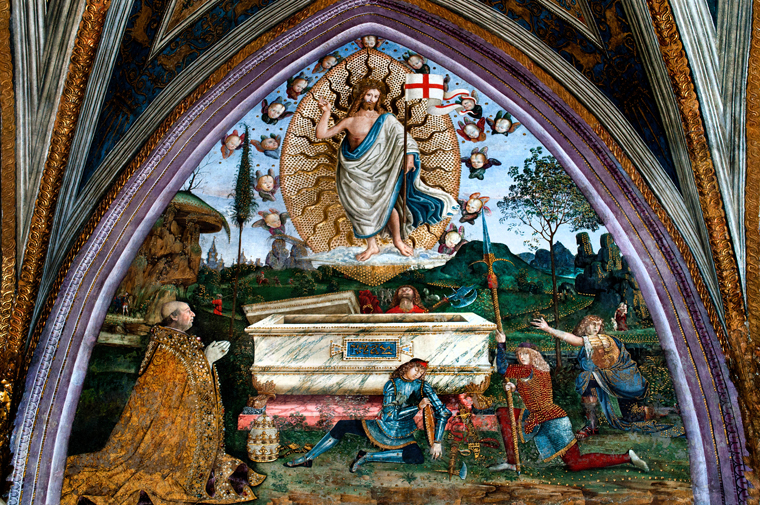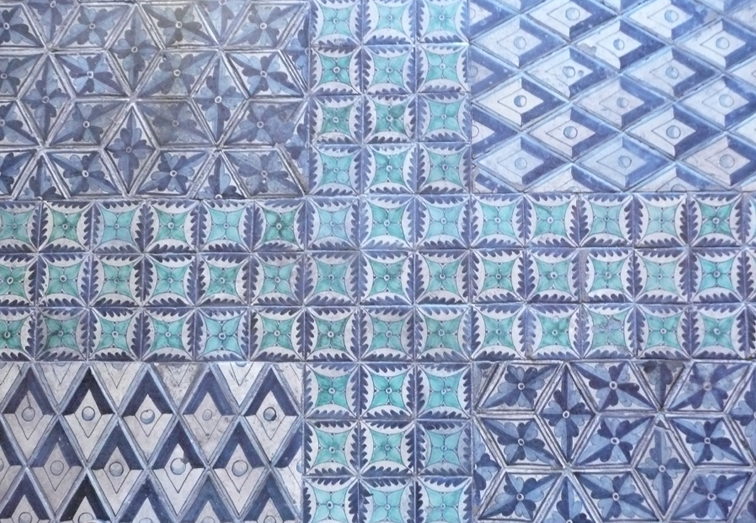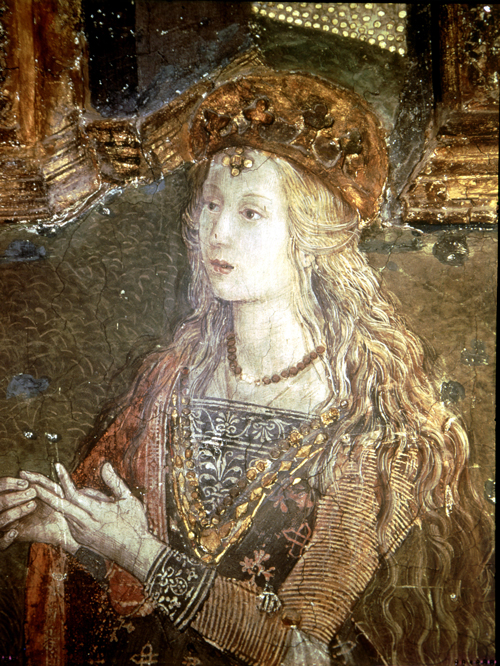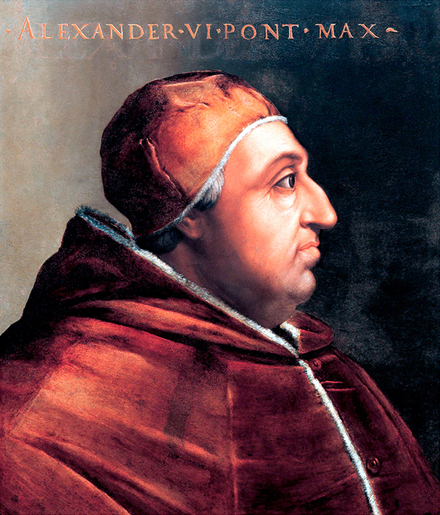The Borgias as Patrons of Arts in the Renaissance
Become and Instant Adept on the Borgias
With their lust for power, fortune and fame, the Borgias were the Renaissance era'southward well-nigh infamous – and intriguing – family. Sarah Dunant opens a window on their earth.
ane. IT'S ALL Most THE CONTEXT
The Borgia family rose to ability in the 1490s as the early Renaissance was at its superlative – all the same nosotros never talk about this dynasty in terms of art, only villainy. The truth is more complex.
If Rodrigo Borgia, Pope Alexander Vi (1431–1503), was not a good guy, then neither were many effectually him. This was a roughshod time in history. He was non the get-go nor the terminal pope to purchase himself into the task, or to have a mistress or children (although he did have more than well-nigh). The Cosmic Church was, at many levels, painfully corrupt. Just at the aforementioned time it was a primal actor in financing some of the greatest new art. The building of the Sistine Chapel and new St Peter'due south were both financed past imposing fresh taxes, the last of which would see Martin Luther rising up in protestation, starting a religious revolution.
Just what made the Borgia pope dissimilar was that he was too a foreigner – from Spain – and he went on to use his children to attempt and create a new dynastic ability in Italy. He failed. Simply but just. And history, written by the victors, wasted no time in making him a worse monster than he was.

2. DON'T MISS RODRIGO BORGIA'Due south TOWER
Pope Alexander 6 was responsible for one slice of notable artistic patronage that we hear niggling about. On coming to power, he built a new tower to go with an old fly of the Vatican and commissioned the Roman artist Pinturicchio (1454–1513) to decorate them both.
Though Pinturicchio's proper noun would be overshadowed by those who came after, he was no artistic slouch, and these apartments – now used by a somewhat embarrassed Catholic Church as a backdrop to religious art – are enormously impressive.
Recent restoration has also suggested that they hide a few secrets.
In a lunette above one of the doors, the pope is seen witnessing the Resurrection of Christ (zilch new here: rich clerics often deputed images of miracles with themselves every bit spectators). But close inspection of the area straight above the tomb has revealed a few tiny, naked, dancing figures.
The ornamentation was done in 1493/94, not long later on Columbus had struck land in the New World. Nosotros know that Columbus wrote letters to the pope describing the voyage and the inhabitants he met on that first visit. Such information would take been a hot topic for discussion in the Vatican at that time. Might these just be the offset visual images of men of the new earth? We will never know for sure. Simply what a story.

3. REMEMBER TO Await DOWN
When it comes to affectionate Renaissance art, nosotros spend a lot of time looking at the walls, only the Borgia apartments within the Vatican also have the most stunning floor, which has remained untouched since information technology was get-go put down in the 1490s.
Considering Rodrigo Borgia was Spanish, he yearned for certain luxuries that reminded him of his youth in Valencia. For example, he had Spanish orange trees planted in the Vatican garden, and so he could smell their blossom in spring.
When it came to his floor tiles, he had them made in the state of Naples, ruled by a branch of the Spanish purple family unit. Their hot blue colours and geometric designs speak of a history of decoration where Spanish and Moorish cultures collide. They were all finally laid by 1496. If yous ever have the run a risk to visit, expect difficult enough and yous volition find the engagement on one tile.
4. THE BIGGEST VILLAIN OF THEM ALL
In that location is not much one can practice to rehabilitate Cesare Borgia (1475–1507), the pope's eldest son. His quick intelligence, sociopathic amuse and utter ruthlessness make him a powerful figure in history.
He leads an army across Italia, conquering a number of metropolis states to bring them under Borgia control. In The Prince, Machiavelli will cite him every bit a man blest with superior political acumen (not the same every bit virtue) and immense expert fortune; but that skilful fortune will desert him with the death of his father. He will spend his concluding years in a Spanish jail.
At the height of his success, Cesare employs Leonardo da Vinci as an builder engineer to amend defences in his castles, and it is idea that Leonardo did some sketches of him at that time. Cesare would take been 27, and his early on, much vaunted, skilful looks were already affected by syphilis, a new and deadly sexual disease which he, and many others at the time, had contracted when it arrived, it is thought, with the sailors and soldiers who travelled with Columbus to the New World, in the 1490s.
5. A TRULY WICKED Adult female?

Out of all the family, Lucrezia Borgia (1480–1519) has suffered most at the hands of history. But then it is especially easy to slander the woman at this period. She will exist defendant of incest, lasciviousness, poisonous substance and murder. The truth makes for less sensational re-create, but is a poignant story.
Lucrezia was merely 13 when her male parent became pope - the perfect age to be used as a pawn in the matrimony game. By the age of 21 she had had three husbands. Her first union was annulled; her second husband was murdered and, past the end of her life, she was the Duchess of Ferrara. Though this marriage was also political, she went on to become a much-loved figure in this lovely little Renaissance country, running the regime while her hubby was abroad fighting, heading a courtroom and even funding convents (she seems to have been the only genuinely religious i in the family).
History and art, even so, offers the states a doctored version of Lucrezia, as the goddess Flora with a dripping dagger. In truth, the only reliable portrait is from the Borgia flat, where Pinturicchio uses the 13-year-erstwhile equally a model for St Catherine of Alexandria (above). Have your pick as to which you would like to believe.
SARAH'S TOP TIP
When international travel is easier once again, the Vatican apartments are well worth a visit. Most people rush through them on their style to the Sistine Chapel, simply take the chance to pause and accept them in.
Cesare Borgia campaign trails brand for a keen Italian road trip through the cities of the Emilia-Romagna region. Have the ancient Via Emilia – a Roman road, it runs direct as an pointer – from Bologna to Imola, Forli, Faenza and Cesena.
RECOMMENDED READS
- Cesare Borgia: His Life and Times and Lucrezia Borgia: Life, Love and Death in Renaissance Italy by Sarah Bradford
- The Borgias by Michael Mallett
- Yous tin also read Sarah's fiction publications:Claret and Beauty andIn The Name of the Family unit
OUR Good'S STORY
Sarah Dunant is a novelist, broadcaster and critic. She has published 13 novels and gives lectures on Renaissance studies and creative writing. Her concluding five novels accept been set inside the Italian Renaissance. Among her talks for The Arts Order areThe Borgias, the nigh infamous family in history? andBackside the walls: creativity, visions and horrors in Renaissance Italian convents.
IF YOU ENJOYED THIS INSTANT EXPERT EMAIL...
Why non forwards this on to a friend who you think would enjoy it too?
Stay in bear on with The Arts Society! Head over to The Arts Society Connected to bring together discussions, read weblog posts and sentry Lectures at Abode – a series of films by Arts Society Accredited Lecturers, published every fortnight.
Show me another Instant Proficient story
boucicaulthato1970.blogspot.com
Source: https://theartssociety.org/arts-news-features/become-and-instant-expert-borgias
